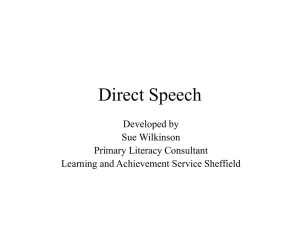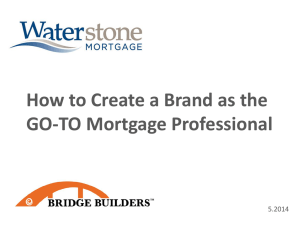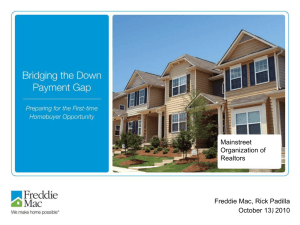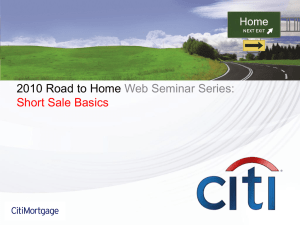Bridging the Down Payment Gap
advertisement
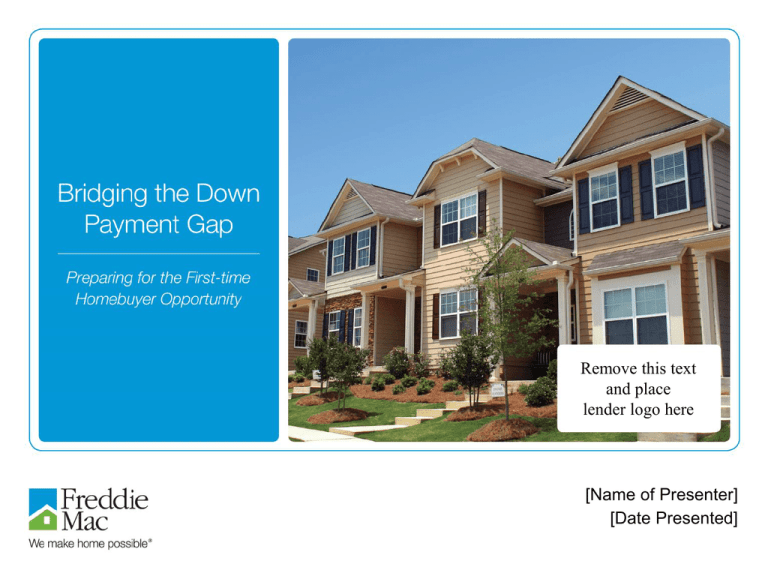
Remove this text and place lender logo here [Name of Presenter] [Date Presented] Remove this text on slide master and place lender logo here Today’s Presentation It’s Still a Great Time to Buy Today’s First-time Homebuyers Bridging the Gap: Down Payment and Closing Cost Resources Down Payment and Closing Cost Resources in Your Area Putting These Programs into Action for Your Business and Your Clients 2 © Freddie Mac 2015 Remove this text on slide master and place lender logo here It’s Still a Great Time to Buy 3 © Freddie Mac 2015 Remove this text on slide master and place lender logo here Low Interest Rates + Low Home Prices = Affordability 4 © Freddie Mac 2015 Remove this text on slide master and place lender logo here Refinances Are Still High, New Purchases Increasing 5 © Freddie Mac 2015 Remove this text on slide master and place lender logo here Today’s First-time Homebuyers 6 © Freddie Mac 2015 Remove this text on slide master and place lender logo here First-time Homebuyers Today 2014 Homebuyer Profile First-time Homebuyer – Demographic Characteristics FTHB share is lower by five percent -- from 38 percent in 2013 to 33 percent in 2014 Married couples represent 54 percent of FTHBs Single female buyers represent 18 percent of FTHBs Single male buyers represent 11 percent of FTHBs FIRST-TIME HOMEBUYER DEMOGRAPHICS Repeat Buyer 52% First-time Homebuyer 33% First-time Homebuyer Other 2% Repeat Buyer Unmarried Couple 15% Married couple Single Male Buyer 11% Single Female Buyer 18% Source -- National Association of REALTORS Profile of Home Buyers and Sellers 2014 © Freddie Mac 2015 Single Female Buyer Married Couple 54% Single Male Buyer Unmarried Couple Other 7 Remove this text on slide master and place lender logo here Age of First-time Homebuyers Homebuyer Age First-time homebuyers are younger than repeat buyers. Age of First-time Homebuyers Age 2012 2013 2014 18-24 9% 8% 9% The largest demographic, 25-34 years old, continues at 56 percent. 25-34 54% 59% 56% 35-44 19% 19% 19% Median age of first-time homebuyers is 31 years old. 45-54 10% 8% 8% 55-64 5% 5% 6% 65-74 2% 1% 1% 75+ 0% <% <1% Source -- NATIONAL ASSOCIATION of REALTORS Profile of Home Buyers and Sellers 2014 © Freddie Mac 2015 8 Remove this text on slide master and place lender logo here Projected Population Increase – 2010-2050 Population Growth 2010–2050 White 2010 2020 2030 2040 2050 246,630 266,275 286,109 305,247 324,800 (7.97%) (7.45%) (6.69%) (6.41%) Black 2010 2020 2030 2040 2050 Percentage Change 55% 50% 45% 39,909 44,389 48,728 52,868 56,944 (11.23%) (9.77%) (8.50%) (7.71%) 14,415 18,756 23,586 28,836 34,399 (30.11%) (25.8%) (22.26%) (19.29%) 40% 35% 2010 2020 2030 2040 2050 30% Asian 22.70% 25.94% 33.46% 19.29% 22.26% 25.8% 7.71% 8.50% 9.77% 5% 11.23% (33.46%) (29.48%) (25.94%) (22.70%) 6.69% 10% 6.41% 49,726 66,365 85,931 108,223 132,792 15% 7.45% 2010 2020 2030 2040 2050 30.11% Hispanic 20% 29.48% 25% 7.97% 2010 2020 2030 2040 2050 0% White Black Asian Hispanic Source -- U.S. Census Data 2008 and 2009 9 © Freddie Mac 2015 Remove this text on slide master and place lender logo here What Does This All Mean for You and Your Clients? Low interest rates + low home prices = affordability. 2015-16: less refinances, more purchases. There are opportunities out there to sell more homes to first-time homebuyers and grow your business. Many well-qualified first-time homebuyers need your assistance to overcome fears. Many first-time homebuyers will need to seek ways to bridge small gaps in down payment and closing costs. 10 © Freddie Mac 2015 Remove this text on slide master and place lender logo here You Are the Critical Link You are the critical link to helping well-qualified homebuyers achieve their homeownership objectives. Help first-time homebuyers understand home financing in new market. Guide eligible first-time homebuyers in choosing homes that they can afford and keep. Result: First-time homebuyer dream realized – and more sales closed for you. 11 © Freddie Mac 2015 Remove this text on slide master and place lender logo here Bridging the Gap: Down Payment, and Closing Cost Assistance Resources 12 © Freddie Mac 2015 Remove this text on slide master and place lender logo here Sources of Funds Assistance from a variety of sources is available for mortgage-ready, well-qualified first-time homebuyers who need a little bit more to bridge the gap: – Mortgage Credit Certificates; and – Down payment and closing cost assistance (grants and deferred seconds) offered through either HUD’s HOME Investment Partnerships Program or the Community Development Block Grant Program that are used to administer programs on the state or local level. An example of a program is the Neighborhood Stabilization Program. Assistance may be limited to first-time homebuyers and/or low- and moderateincome homebuyers, depending on the assistance program. Homebuyer education counseling is often required, but not always. Source – HUD and NCSHA 13 © Freddie Mac 2015 Remove this text on slide master and place lender logo here Sources of Funds Mortgage Credit Certificates (MCCs) Issued by certain state or local governments (including state housing finance agencies), MCCs generally allow homeowners to claim around 20 percent of the annual interest on their mortgage as a federal tax credit every year for the life of the original first mortgage (details vary by state). Amount of credit per mortgage loan capped by Internal Revenue Service @ $2,000 per year. NOTE: Although MCCs are not a down payment assistance source, mortgage lenders often use the estimated amount of the credit on a monthly basis as additional income to help the potential borrower qualify for the loan. Source – NCSHA and Wikipedia® 14 © Freddie Mac 2015 Remove this text on slide master and place lender logo here Mortgage Credit Certificates (cont’d) Homebuyers who wish to obtain an MCC must meet certain minimum guidelines (restrictions may be waived by issuing entity in certain circumstances): – Must not have owned a home in the previous three years; – Must meet income and purchase price restrictions; and – Must use the new home as a primary residence. Source – NCSHA and Wikipedia® 15 © Freddie Mac 2015 Remove this text on slide master and place lender logo here How Mortgage Credit Certificates Work Borrower receives an MCC for: 30% credit $200,000 mortgage 30-year, fixed-rate Results: 6% interest rate Total tax credit in this example exceeds IRS limit of $2,000 Homebuyer reports a $2,000 credit on tax return Allowable Tax Credit: Mortgage Interest Paid (First Year): $11,933 Homebuyer may continue to receive a tax credit for as long as they remain in home and retain mortgage X 0.30 (30% MCC Credit) = Total Credit: $3,579 For illustrative purposes only. Borrowers should always check with their tax advisor to determine any potential tax benefits. Source – Wikipedia® © Freddie Mac 2015 16 Remove this text on slide master and place lender logo here Sources of Funds Down payment and closing cost assistance Most assistance is provided to the mortgage-ready borrower through grants and deferred seconds funded by states and local governments through: – the HOME Investment Partnerships Program; and – the Community Development Block Grant (CDBG) Program (which includes the Neighborhood Stabilization Program). Source -- HUD 17 © Freddie Mac 2015 Remove this text on slide master and place lender logo here Sources of Funds Grants Grants are funds that do not have to be paid back, but often have to be paid back if the borrower sells his or home within a certain period of time. Deferred Seconds Many down payment assistance programs come in the form of a second mortgage that has a low interest rate and/or deferred payments. Source -- HUD 18 © Freddie Mac 2015 Remove this text on slide master and place lender logo here HOME Investment Partnerships Program Administered by HUD, HOME is the largest federal block grant to state and local governments (including housing finance agencies), and is designed exclusively to create affordable housing for low-income households (those earning 80 percent or less of the area median income). HOME provides annual formula grants to states and localities that communities use – often in partnership with local nonprofit groups – to fund a wide range of activities that build, buy, and/or rehabilitate housing for homeownership or rental, or provide direct rental assistance to low-income individuals and families. Provides participating jurisdictions with a line of credit to draw upon, as needed, to use for grants, direct loans, loan guarantees or other forms of credit enhancement, or rental assistance or security deposits. Source – HUD and Wikipedia® 19 © Freddie Mac 2015 Remove this text on slide master and place lender logo here HOME Investment Partnerships Program (cont’d) States are automatically eligible for HOME funds and receive either their formula allocation or $3 million, whichever is greater. Local jurisdictions eligible for at least $500,000 under the formula can receive an allocation. Communities that do not qualify for an individual allocation under the formula can join with one or more neighboring locality so that members’ combined allocation would meet the threshold for direct funding. Eligible jurisdictions receiving funds must provide 25 cents of their own funds for every HOME dollar received. State and local government HOME grantees (or designees) administer these programs and accept applications from eligible mortgage-ready borrowers seeking funding. Source – HUD and Wikipedia® 20 © Freddie Mac 2015 Remove this text on slide master and place lender logo here Down Payment and Closing Cost Assistance Example – [Add Type of Assistance Here] XX City, XX State – [Add Name of Program Here] Describe program here [USE THIS SLIDE TO PROVIDE A SPECIFIC EXAMPLE OF A DOWN PAYMENT AND CLOSING COST ASSISTANCE PROGRAM IN YOUR LOCAL AREA OR LENDING FOOTPRINT.] Source – [Add Here] 21 © Freddie Mac 2015 Remove this text on slide master and place lender logo here Community Development Block Grant (CDBG) Program One of HUD’s longest-running programs (since 1974), the CDBG provides communities with resources to address a wide range of unique community development needs including affordable housing, anti-poverty programs, and infrastructure development. CDBG funds are allocated to more than 1,100 local and state governments called “entitlement” and “non-entitlement” communities. Entitlement communities – Annual grants to larger cities and urban counties to develop viable communities by providing decent housing, a suitable living environment, and opportunities to expand economic opportunities, principally for low- and moderate-income persons. Source – HUD and Wikipedia® 22 © Freddie Mac 2015 Remove this text on slide master and place lender logo here Community Development Block Grant Program (cont’d) With Non-entitlement Communities or State Administered CDBG (also known as the Small Cities CDBG Program), states award grants to smaller units of general local government for community development activities. Annually, each state develops funding priorities and criteria for selecting projects. HUD determines the amount of each CDBG entitlement grant by a statutory dual formula which uses the needs of the community, extent of poverty, population, housing overcrowding, age of housing, and population growth lag in relation to other metropolitan areas. CDBGs differ from categorical grants; they are made for specific purposes in that they are subject to less federal oversight and are largely used at the discretion of the state and local governments and their subgrantees. CDBG grantees, or nonprofit designees, administer these programs and accept applications from eligible mortgage-ready borrowers seeking funding. Source – HUD and Wikipedia® 23 © Freddie Mac 2015 Remove this text on slide master and place lender logo here Neighborhood Stabilization Program (NSP) A component of CDBG, HUD provides Neighborhood Stabilization Program grants to communities hardest hit by foreclosures and delinquencies to purchase, rehabilitate, or redevelop homes and stabilize neighborhoods. Grantees (government agency or nonprofit administering the program) develop their own programs and funding priorities, but must use at least 25 percent of the funds appropriated for the purchase and redevelopment of abandoned or foreclosed homes or residential properties that will be used to house individuals or families whose incomes do not exceed 50 percent of the area median income. All activities funded by NSP must benefit low- and moderate-income persons whose income does not exceed 120 percent of the area median. Source -- HUD © Freddie Mac 2015 24 Remove this text on slide master and place lender logo here Neighborhood Stabilization Program (cont’d) Eligible NSP activities can include (but are not limited to): – Direct purchase and rehabilitation of abandoned and foreclosed homes for sale, rent, or redevelopment; – Establishment of financing mechanisms for purchase and redevelopment of foreclosed homes and residential properties; and – Demolition of blighted structures. NSP funds can be used to help homebuyers purchase homes and the borrower must apply through the NSP grantee. Source -- HUD © Freddie Mac 2015 25 Remove this text on slide master and place lender logo here Down Payment and Closing Cost Assistance Example – [Add Type of Assistance Here] XX City, XX State – [Add Name of Program Here] Describe program here [USE THIS SLIDE TO PROVIDE A SPECIFIC EXAMPLE OF A DOWN PAYMENT AND CLOSING COST ASSISTANCE PROGRAM IN YOUR LOCAL AREA OR LENDING FOOTPRINT.] Source – [Add Here] 26 © Freddie Mac 2015 Remove this text on slide master and place lender logo here How Government Grants and Loans Can Help Borrowers Buy Their First Home YOUR BORROWER’S NEW HOME FIRST MORTGAGE Obtain a 30-year fixed-rate conventional mortgage and combine it with a Mortgage Credit Certificate to lower the borrower’s monthly payment and maximize his or her purchasing power. Home Purchase Price + Closing Costs __________________________ TOTAL REQUIRED TO CLOSE First Mortgage Borrower obtains a 30-year conventional fixed-rate loan + Mortgage Credit Certificate (MCC), when available Money Out of Pocket Borrower’s personal contribution towards the purchase can be as low as 3% of the MONEY OUT OF POCKET Borrower’s personal contribution. purchase price “GAP” LOAN These loans fill the gap between what you can qualify for on your own and the actual price of the home. These loans don’t require any monthly payments. “Gap” Loan Silent second loan from a local government agency requires no monthly payment and, therefore, is not counted as a borrower’s debt during underwriting Other Assistance Programs Remaining down payment or closing cost assistance needed to close the loan (can include seller concessions) © Freddie Mac 2015 OTHER ASSISTANCE PROGRAMS If the “gap” loan isn’t sufficient to close the loan, these programs give extra help with the borrower’s down payment and closing costs. Seller concessions can be applied here. 27 Remove this text on slide master and place lender logo here Down Payment and Closing Cost Resources in [Insert Location Here] 28 © Freddie Mac 2015 Remove this text on slide master and place lender logo here Down Payment and Closing Cost Assistance Programs in [Insert Location Here] Statewide and Regional Programs: [Add here] City/County Programs: [Add here] Municipal Programs: [Add here] Counseling Agencies Providing HUD-approved Homebuyer Education: [Add here] [CUSTOMIZE THIS PAGE USING INFORMATION FROM HUD’S WEBSITE @ http://portal.hud.gov/hudportal/HUD?src=/states TO LIST DOWN PAYMENT AND CLOSING COST ASSISTANCE PROGRAMS OFFERED IN THE STATE, REGION, CITY, COUNTY, AND MUNICIPALITY -- ALONG WITH THE LIST OF COUNSELING AGENCIES OFFERING HOMEBUYER EDUCATION.] 29 © Freddie Mac 2015 Remove this text on slide master and place lender logo here [Lender: List Your Product Offerings Here] [Name of product] – Description… [Name of product] -- Description… [CUSTOMIZE THIS PAGE TO SHOW YOUR MORTGAGE PRODUCT OFFERINGS, REQUIREMENTS, AND SPECIAL PROGRAMS.] Source – [Add Here] 30 © Freddie Mac 2015 Remove this text on slide master and place lender logo here Why Is Homeownership for Mortgage-Ready, First-time Homebuyers Still Important? Owning a home still has its advantages, both personally and financially: – housing costs are more stable if the first-time homebuyer obtains a fixed-rate mortgage (still available at historically low rates); – tax incentives such as the mortgage interest deduction not offered to renters; and – mortgage-ready borrower obtains a sustainable mortgage at an affordable rate using available down payment and closing cost assistance. 31 © Freddie Mac 2015 Remove this text on slide master and place lender logo here Contact Information [CUSTOMIZE THIS PAGE TO INCLUDE YOUR CONTACT INFORMATION, “800” NUMBER, NAME OF A SPECIFIC LOAN OFFICER, ETC.] 32 © Freddie Mac 2015
